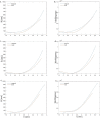Birefringent properties of the cornea measured by a Mueller type polarimeter in healthy adults and children
- PMID: 35003872
- PMCID: PMC8713654
- DOI: 10.1364/BOE.440274
Birefringent properties of the cornea measured by a Mueller type polarimeter in healthy adults and children
Abstract
Mueller type polarimeter was used for in vivo measurements of the anisotropic parameters (retardation and azimuth angle) of corneas. To determine birefringence, corneal thickness was measured with a Scheimpflug camera (Corvist ST). The retardation distributions in the nasal-temporal cross-section in both children (N=7) and adults (N=38) groups occurred asymmetrical. The asymmetry in birefringence distributions was observed only in adults group. The geometrical analysis of the first order isochromes in both age groups showed the asymmetry of its shapes. The changes of symmetry in birefringent properties with age may have potential relationship with changing corneal biometry.
© 2021 Optical Society of America under the terms of the OSA Open Access Publishing Agreement.
Conflict of interest statement
The authors declare that there are no conflicts of interest related to this article.
Figures






References
-
- Bartholin R., “An account of sundry experiments made and communicated by that learn’d mathematician, Dr. Erasmus Bartholin, upon a chrystal-like body, sent to him out of Island,” Philos Trans R Soc. 5, 2041–2048 (1670).
-
- Brewster D., “Experiments on the de-polarization of light as exhibited by various mineral, animal and vegetable bodies with a reference to the general principles of polarization,” Philos. T. R. Soc. Lond. 105, 21–53 (1815).
-
- Kokott W., “Uber mechanisch-funktionelle Strukturen des Auges,” Graefe’s Arch. Clin. Exp. Ophthalmol. 138(4), 424–485 (1938).10.1007/BF01856375 - DOI
-
- Maurice D. M., The Eye: The Cornea and Sclera , Davson H., ed. (Academic Press, 1984).
-
- Daxer A., Fratzl P., “Collagen fibril orientation in the human corneal stroma and its implication in keratoconus,” Invest. Ophthalmol. Visual Sci. 38(1), 121–129 (1997). - PubMed
LinkOut - more resources
Full Text Sources
